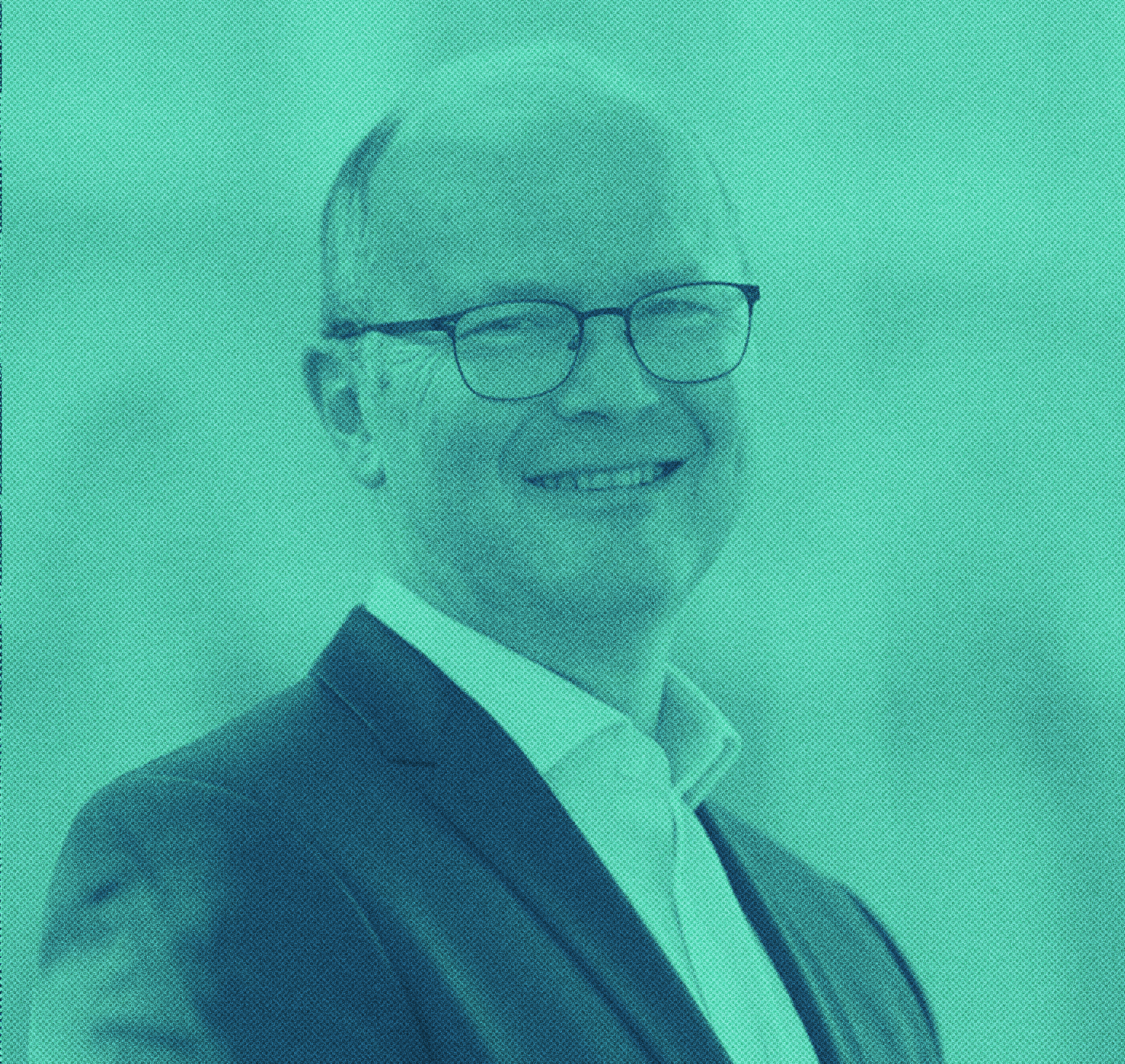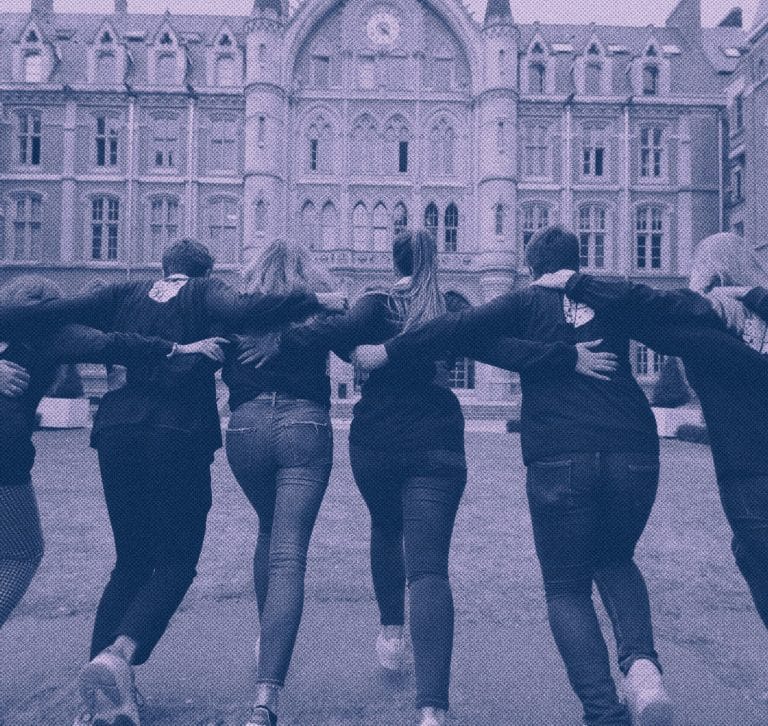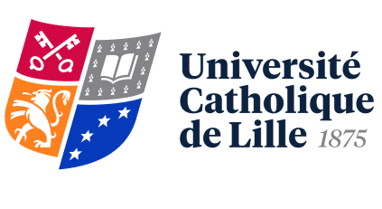Recall
History
Founding of the University
On 12 October 1875, three months after the passing of the law on the freedom of higher education, the foundation declaration and first statutes of the Institut Catholique de Lille were issued. This rapid creation was due to the courage of its founders, who had anticipated the law by opening free law courses on rue Royale in November 1874, and had obtained the blessing of Pope Pius IX. These initiatives were born of the commitment of the bishops of Arras and Cambrai, and of industrialists, in particular the two brothers-in-law Philibert Vrau and Camille Feron-Vrau, key figures in the history of Lille and la Catho. As of 1877, the Université Catholique de Lille had five faculties: Law, Literature, Science, Medicine, and Theology.
First healthcare facilities
In 1877, Camille Feron-Vrau, the doctor behind the creation of the Faculty of Medicine and Pharmacy, met Mère Saint-Paul, who had come from Lyon to realize her dream of founding a hospital for incurable women. The two worked together to found the Asile des Cinq Plaies on Boulevard Victor Hugo. This was joined, in 1890, by the Saint-Antoine de Padoue children’s hospital, also created by the pair. Today, the complex has been transformed into the EHPAD Saint-Antoine de Padoue, under the auspices of the Association du Centre Feron-Vrau.
Start of construction
Thanks to a generous “anonymous” donation from Philibert Vrau, large plots of land were acquired on boulevard Vauban. In several stages over several decades, a large architectural complex was built to house not only classes, but also student accommodation. It would soon also include healthcare facilities, the Sainte-Anne maternity hospital and the Saint-Raphaël dispensary. Architect Louis Dutouquet and builder Émile Rouzé chose the Gothic style to symbolize the Catholic character of the university. Since 1879, the Vauban campus has undergone constant transformation and expansion. Today, it extends from IESEG to ICAM, via the Palais Rameau.
Creation of HEI
It was also under the impetus of Camille Feron-Vrau that the Ecole des hautes études industrielles (HEI) was created on November 12, 1885, in conjunction with the Faculté Libre des Sciences. In 1906, it added a business section, which would become EDHEC fifteen years later. In the 1950s, HEI continued to expand. In 2020, it joined JUNIA, the school for transitional engineers, with ISA and ISEN.
Blessing of the University Chapel
The university chapel was planned as early as the first construction projects for the academic building. Due to lack of funds and the First World War, construction had to wait until the 1920s. Blessed in 1924, it was decorated five years later with colorful stained glass windows by Pierre Turpin and Henri Morin, based on an iconographic program devised by Rector Emile Lesne. In 2020, a major renovation project will give the church a new lease of life.
Creation of the Polyclinique Saint-Philibert
In 1890, a dispensary called Saint-Camille was set up on rue de la Bassée. In 1933, the adjacent Polyclinique Saint-Philibert was inaugurated. This innovative new facility enabled students to study different types of illness (neurological, optical and mental, for example). In 1977, the polyclinic joined the Saint-Camille dispensary and the Saint-Anne maternity hospital: the whole complex was transferred to Lomme, under the name Hôpital Saint-Philibert. In June 2023, this landmark of the Lomme landscape will be extended to include 16 new operating theatres.
Creation of ISEN
In 1956, Norbert Ségard, an alumnus of the Lille Catholic University, founded ISEN, the Institut Supérieur d’Electronique du Nord, the only state-approved private engineering school at the time. This marked the beginning of a major expansion of schools, particularly engineering schools, within the Catho. ISEN quickly gained a good reputation and later became the Institut Supérieur d’Électronique et du Numérique. Norbert Ségard became Minister of Telecommunications.
1st lay President Rector
Michel Falise, a Belgian economist, had just returned from Harvard when he decided to teach a few courses at the Université Catholique de Lille. In 1960, he decided to stay on full-time. With Norbert Ségard, he was behind the creation of a large number of schools. In 1973, the creation of the Federation brought with it new statutes, which stipulated that the Rector of the Institut Catholique de Lille, who was also President of the University Federation, could be a layman. Seven years later, Michel Falise was appointed to this position, the first in a long line of lay President-Rectors.
Creation of the hospital group
In 1991, Lomme’s Hôpital Saint-Philibert joined the Saint-Camille (different from the dispensary) and Saint-Vincent-de-Paul hospitals to form the Groupe Hospitalier de l’Institut Catholique de Lille (GHICL). Over the years, the group’s member establishments have undergone transformations. Today, this 1,000-bed hospital group has three member establishments: Hôpital Saint-Philibert in Lomme, Hôpital Saint-Vincent de Paul in central Lille, and Clinique Sainte-Marie in Cambrai.
Creation of Humanicité
When she was appointed President-Rector of our University in 2003, Thérèse Lebrun launched the creation of a health cluster around the Saint-Philibert Hospital in Lomme: this was the beginning of Humanicité. Today, this 15-hectare social innovation district includes an EHPAD, training centers, housing and a shared garden. The whole is an example of living together, diversity and accessibility.
Centre Féron-Vrau membership
The Association Centre Feron-Vrau was created in 1970 to develop support for the elderly. In 2009, it joined the Institut Catholique de Lille, which provided it with guidance and support. The association now has five EHPADs in Lille and the Boulonnais region. Its mission is as follows: “To welcome and support, with humanity and dignity, all elderly, dependent and vulnerable people – whatever their means – in collaboration with the Lille Catholic University and local stakeholders”.
EESPIG label
The Université Catholique de Lille is a federation of private, not-for-profit, public-interest establishments. Indeed, since 2014, its establishments have been officially recognized as participating in the public service mission of higher education and research in France.
Signing of the Grenoble agreement
In 2022, the Université Catholique de Lille joined the 50+ signatories to the Grenoble Accord, marking its commitment to the ecological transition. An extension of the Live Tree program launched in 2013.
150 years!
The Université Catholique de Lille celebrates its 150th anniversary. To mark the occasion, a number of exceptional events are being organized, combining conferences, exhibitions and festivities, and highlighting the institution’s past, present and future. This anniversary marks a milestone in the history of the institution, which is focused on innovation and the future.
Live
the Present
Join us to celebrate this memorable anniversary with a series of exclusive events: conferences, concerts, exhibitions and meetings. Discover our program now and reserve your place for the highlights of this unforgettable year.

“Celebrating 150 years of history is about honoring the legacy of those who have shaped our University and affirming our mission for tomorrow.
Together, we have built a place of knowledge and solidarity, where everyone – students, teachers, researchers, caregivers, partners – contributes to weaving a fairer, more sustainable society.
… Let’s continue, together, to weave this thread of history. With the same boldness and passion that have driven us for 150 years.”
Patrick Scauflaire
President-Rector of the Université Catholique de Lille
Events
We invite everyone to contribute to this momentum and help build an even more ambitious and inclusive Université Catholique de Lille.
Build
the Future
While our 150th anniversary marks a symbolic milestone, it also represents a starting point for bold new projects. Research, innovation, sustainable development and international openness: discover the initiatives that will bring our vision to life for future generations.

Continue to experience the joy of learning
How will we learn tomorrow, and for what purpose? Humanity is brimming with potential for imagination and creativity, capable of better understanding the world, inventing new ways of acting and thinking about our life in society, in harmony with nature. The Catholic University of Lille will have to reinvent itself if it is to remain a veritable oasis of intelligence, where we learn to think and acquire new knowledge and skills throughout our lives. Perhaps it will be a new form of UniverCité, a space where everyone can taste the living experience of the joy of learning.
A UniverCité in symbiosis with its territory
Faithful to the intuition of its founders, UniverCité must embody a veritable living laboratory, inspired by Christian social thought, and training explorers for a city open to the world and to others. With 150 years of loyalty to its territory, UniverCité must generously give back what it draws from it. The Lille metropolitan area is a privileged setting for a wide range of experiences, fostering commitment to the common good, the creation of human value and a renewed vision of “caring”. The impetus to dare to praise the future, initiated in 2022, must not only continue, but be amplified.
Research to understand, research to innovate
Faced with today’s major challenges, this dynamic of daring to praise the future must be rooted in research, a fundamental pillar of the University alongside teaching. Research will become more interdisciplinary, offering opportunities for reflection and debate. Founded on science and humanism, guided by rigorous ethics and special attention to the most vulnerable, it will be open to all citizens. The Catholic University of Lille, with its inspiring laboratories, will continue to carry out its research mission by adopting a confident approach to the co-elaboration of knowledge and methods, in close collaboration with all players in society.
Find out more about the University
Discover the identity of the Université Catholique de Lille.
Get a complete picture of the University and its impact on the world of education, care and beyond.
History and heritage
Explore the rich history and exceptional heritage of the Université Catholique de Lille, reflecting decades of commitment to knowledge and innovation.
Vision, mission, values
The Université Catholique de Lille is dedicated to the integral development of the individual, combining academic excellence, research and service to society. Its fundamental values – humanism, ethics and openness – guide its educational mission and its commitment to the common good.
Strategic priorities and major projects
The Université Catholique de Lille’s projects revolve around major strategic axes: socio-ecological transition, ethics, pedagogy… These orientations aim to reinforce its commitment to responsible and innovative education, while responding to contemporary challenges.

